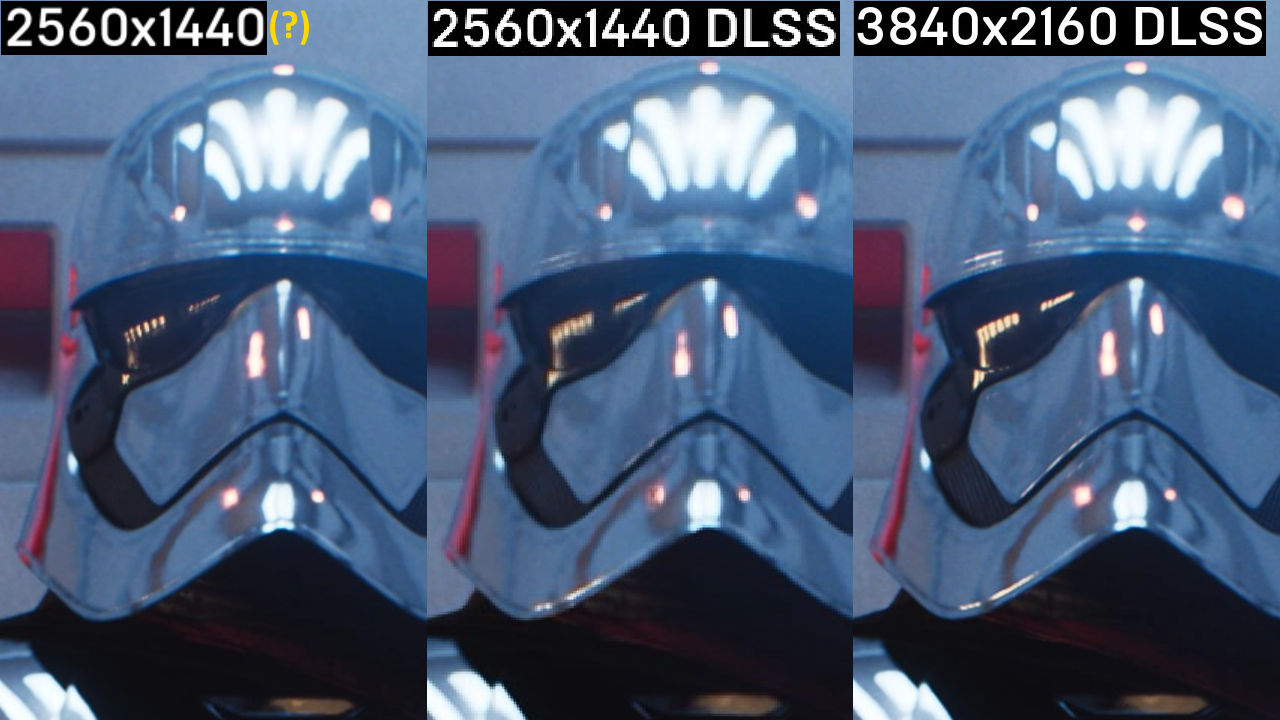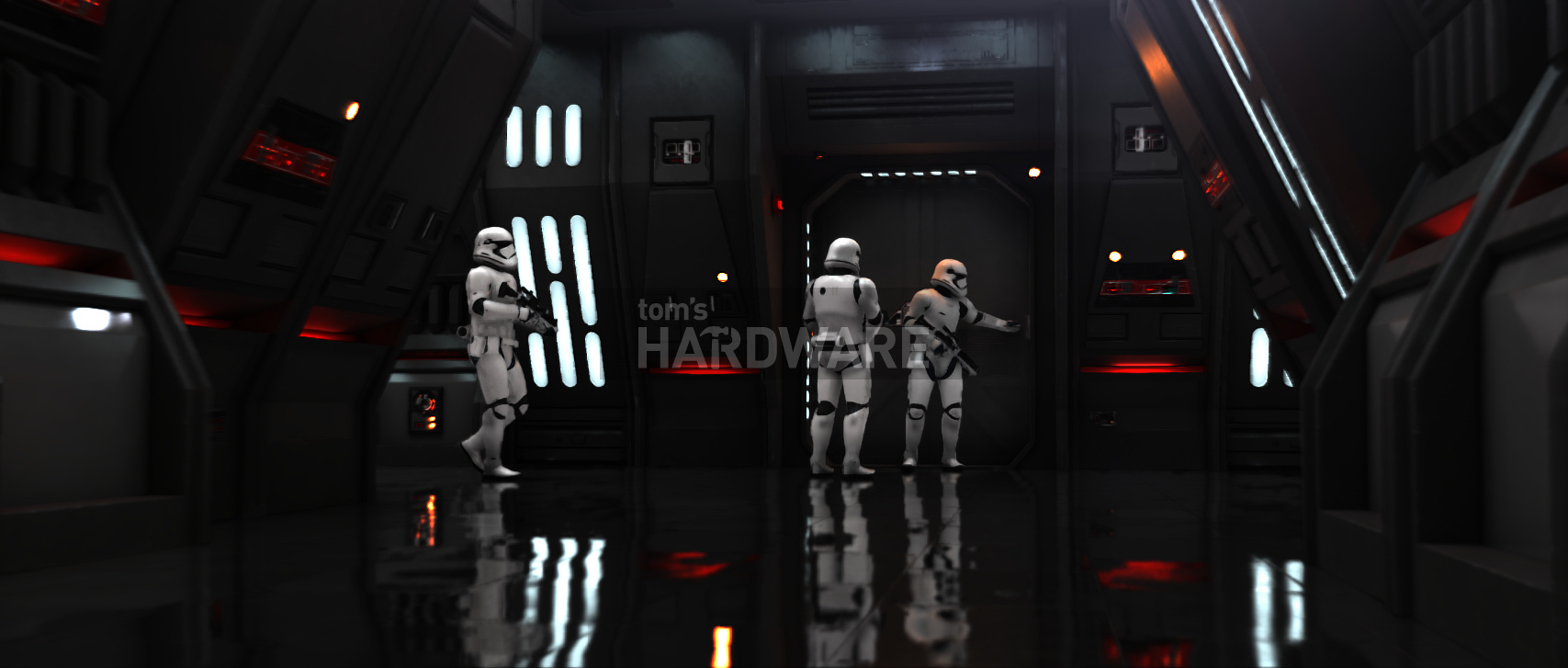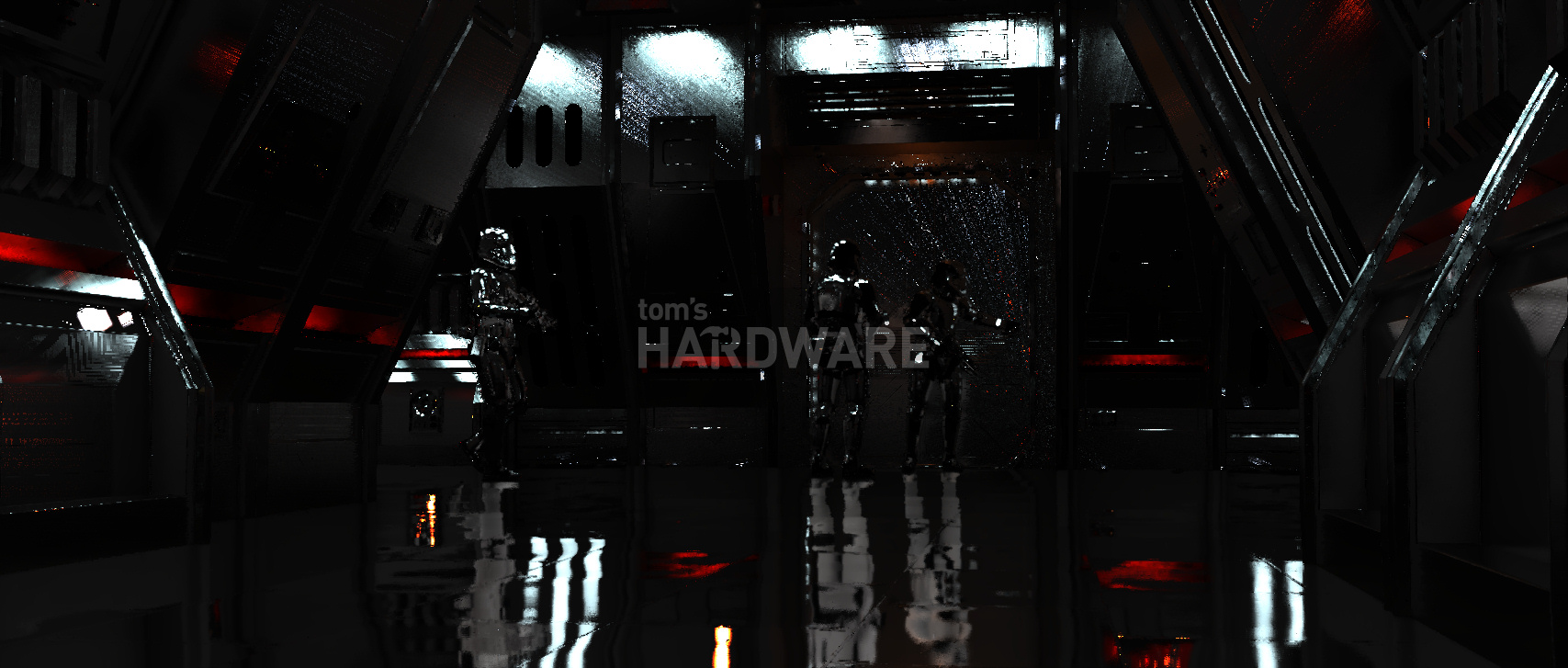Nvidia's DLSS Technology Analyzed: It All Starts With Upscaling
Star Wars Reflections: A Special Case
The Star Wars Reflections demo is even more complex because it combines Nvidia's DLSS and ray tracing technologies in real time. We spent hours scrutinizing screen captures to compare them with no definitive conclusions. There was only one observation we made over and over: the reflection effects are never really identical between the various render modes. Take Captain Phasma's helmet as an example. The lighting in her visor looks different across all three screenshots.
Of course, we learn more from analyzing the render pipeline. Specifying QHD with DLSS enabled results in a base resolution of 1708x964, four pixels taller than the Infiltrator demo, or 728 pixels without the black bands.
Unfortunately, Nvidia's tool doesn't run stably at 4K so we can't say much about that setting.
One detail we didn't see from the other two demos is the addition of DLAA, which is applied to the frame at its base resolution, just before upscaling occurs. Final Fantasy also applies an AA filter prior to upscaling, but we cannot confirm that it's the same type of anti-aliasing.
In the Reflections demo, we have to wonder if DLAA is invoking the Turing architecture's Tensor cores to substitute in a higher-quality ground truth image prior to upscaling?
Bonus: The Ray Tracing Step
As we stepped through the render, we were able to isolate where ray tracing was happening. Two frames apply ray tracing at two different angles, while a third seems to denoise the result. Note also that ray tracing is also calculated prior to upscaling.
MORE: Best Graphics Cards
Get Tom's Hardware's best news and in-depth reviews, straight to your inbox.
MORE: ;Desktop GPU Performance Hierarchy Table
MORE: All Graphics Content
Current page: Star Wars Reflections: A Special Case
Prev Page Analysis of the Rendering Pipeline Next Page Could DLSS be the Future of Entry-Level GPUs?-
hixbot OMG this might be a decent article, but I can't tell because of the autoplay video that hovers over the text makes it impossible to read.Reply -
richardvday I keep hearing about the autoplay videos yet i never see them ?Reply
I come here on my phone and my pc never have this problem. I use chrome what browser does that -
bit_user Reply
Thank you! I was waiting for someone to try this. It seems I was vindicated, when I previously claimed that it's upsampling.21435394 said:Most surprising is that 4K with DLSS enabled runs faster than 4K without any anti-aliasing.
Now, if I could just remember where I read that... -
bit_user Reply
You only compared vs TAA. Please compare against no AA, both in 2.5k and 4k.21435394 said:Notice that there is very little difference in GDDR6 usage between the runs with and without DLSS at 4K. -
bit_user Reply
I understand what you're saying, but it's incorrect to refer to the output of an inference pipeline as "ground truth". A ground truth is only present during training or evaluation.21435394 said:In the Reflections demo, we have to wonder if DLAA is invoking the Turing architecture's Tensor cores to substitute in a higher-quality ground truth image prior to upscaling?
Anyway, thanks. Good article! -
redgarl So, 4k no AA is better... like I noticed a long time ago. No need for AA at 4k, you are killing performances for no gain. At 2160p you don't see jaggies.Reply -
coolitic So... just "smart" upscaling. I'd still rather use no AA, or MSAA/SSAA if applicable.Reply -
bit_user Reply
That's not what I see. Click on the images and look @ full resolution. Jagged lines and texture noise are readily visible.21436668 said:So, 4k no AA is better... like I noticed a long time ago.
If you read the article, DLSS @ 4k is actually faster than no AA @ 4k.21436668 said:No need for AA at 4k, you are killing performances for no gain.
Depending on monitor size, response time, and framerate. Monitors with worse response times will have some motion blurring that helps obscure artifacts. And, for any monitor, running at 144 Hz would blur away more of the artifacts than at 45 or 60 Hz.21436668 said:At 2160p you don't see jaggies. -
s1mon7 Using a 4K monitor on a daily basis, aliasing is much less of an issue than seeing low res textures on 4K content. With that in mind, the DLSS samples immediately gave me the uncomfortable feeling of low res rendering. Sure, it is obvious on the license plate screenshot, but it is also apparent on the character on the first screenshot and foliage. They lack detail and have that "blurriness" of "this was not rendered in 4K" that daily users of 4K screens quickly grow to avoid, as it removes the biggest benefit of 4K screens - the crispness and life-like appearance of characters and objects. It's the perceived resolution of things on the screen that is the most important factor there, and DLSS takes that away.Reply
The way I see it, DLSS does the opposite of what truly matters in 4K after you actually get used to it and its pains, and I would not find it usable outside of really fast paced games where you don't take the time to appreciate the vistas. Those are also the games that aren't usually as demanding in 4K anyway, nor require 4K in the first place.
This technology is much more useful for low resolutions, where aliasing is the far larger problem, and the textures, where rendered natively, don't deliver the same "wow" effect you expect from 4K anyway, thus turning them down a notch is far less noticeable.






